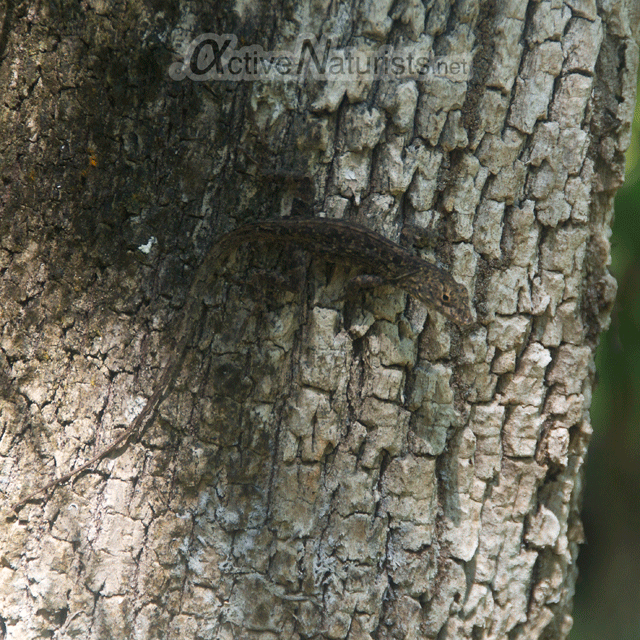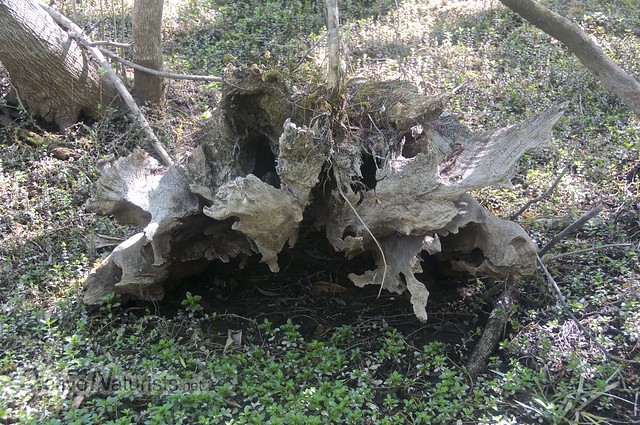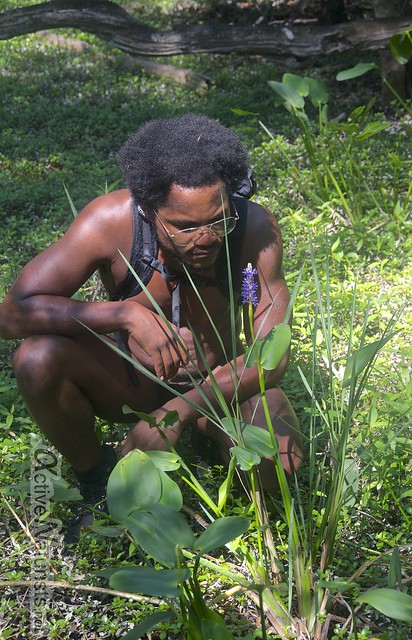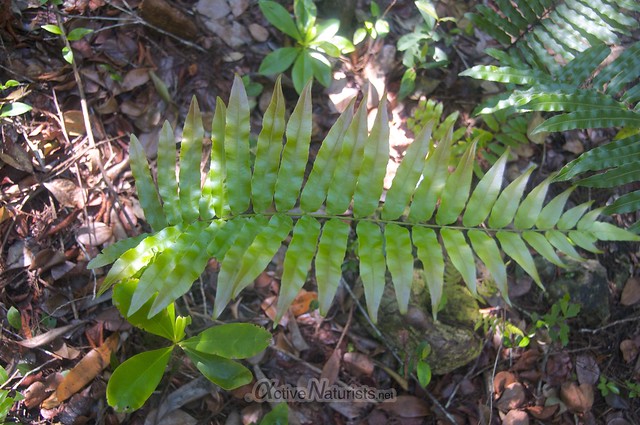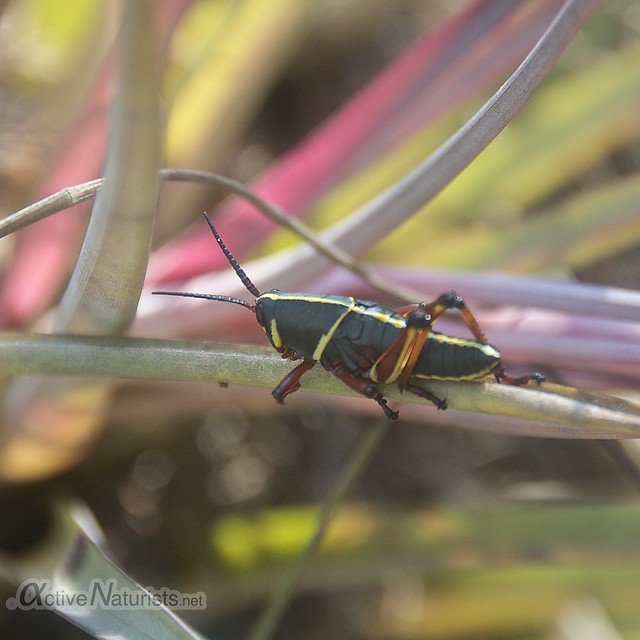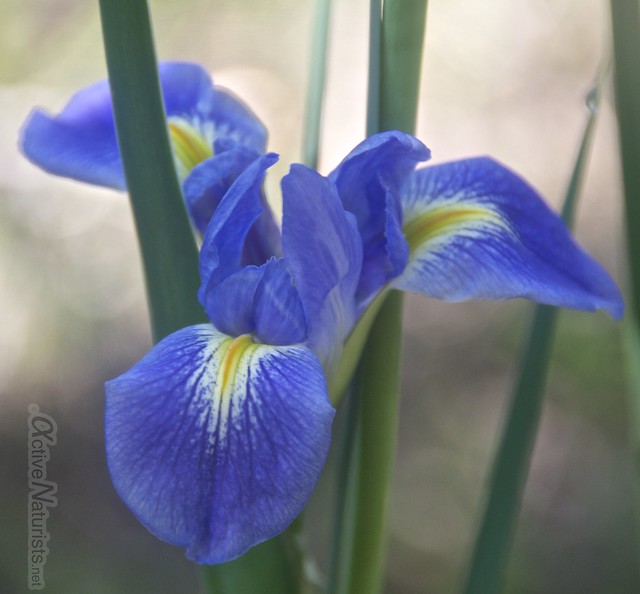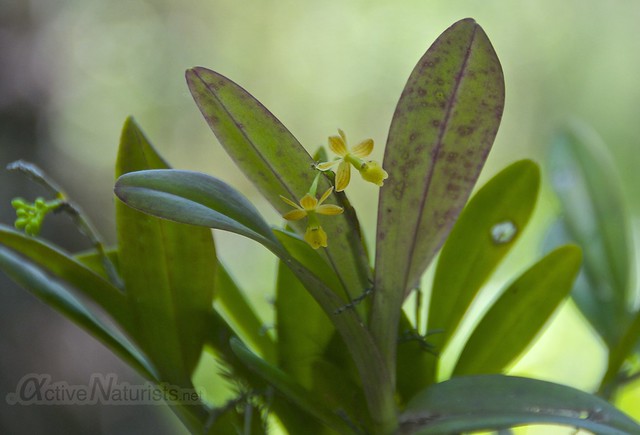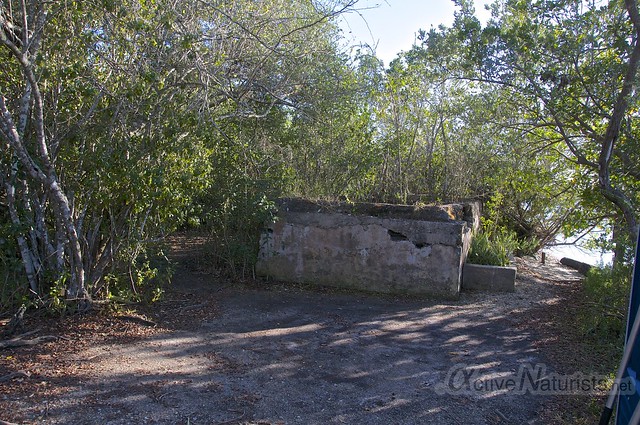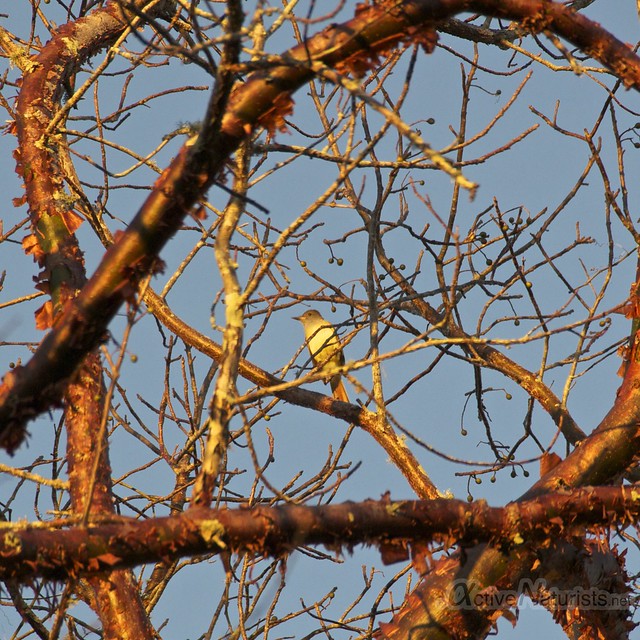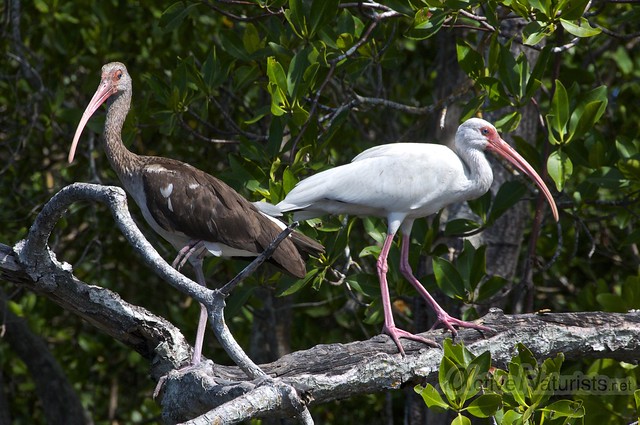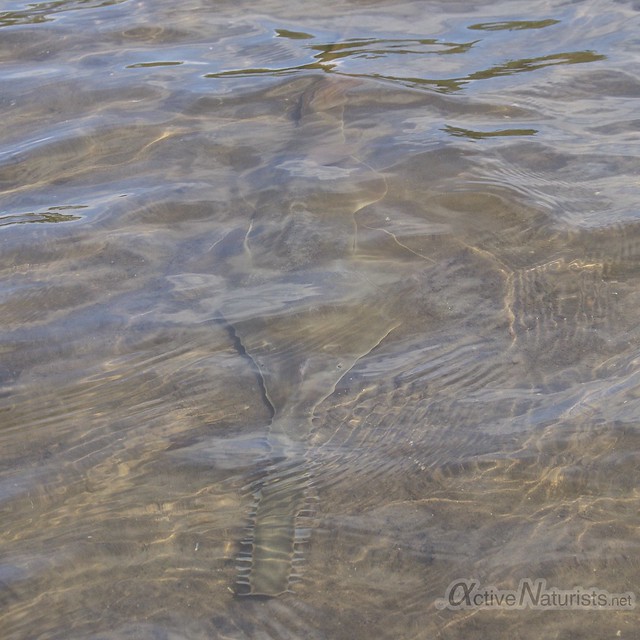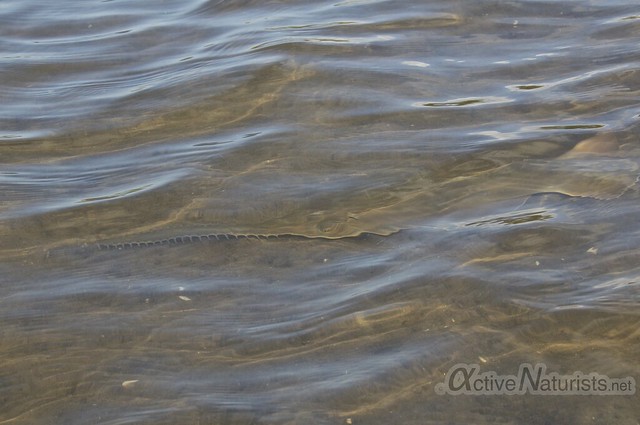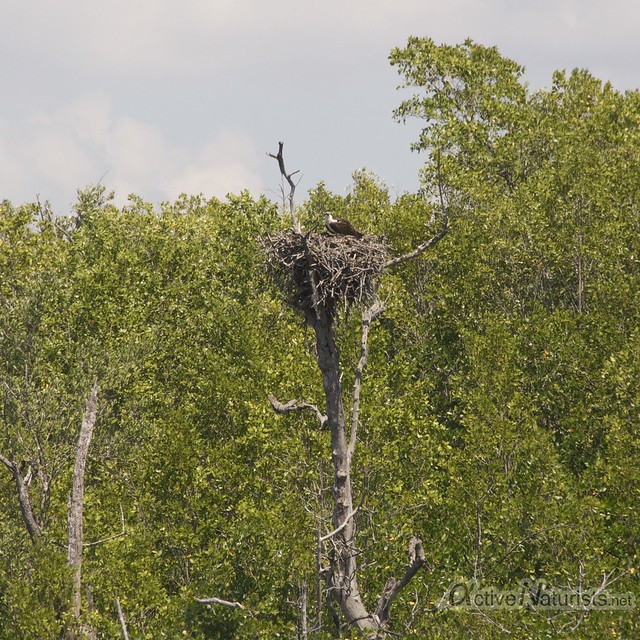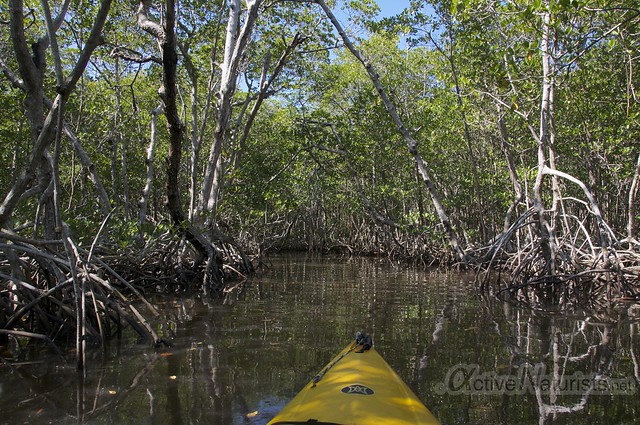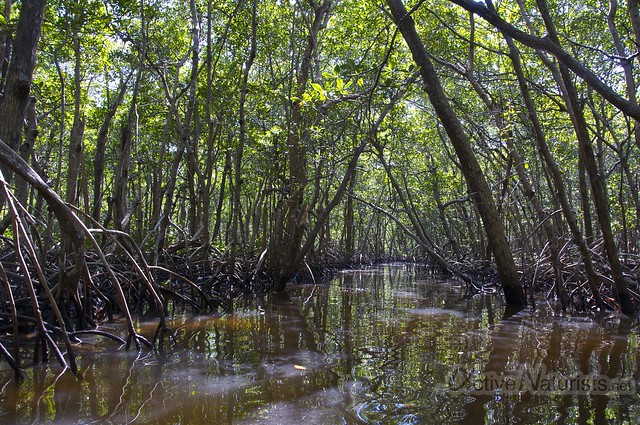You might have been surprised to hear about a hiking trail in South Florida in my previous blogpost, but did you know that you could go canoeing in the Everglades for a week or so without seeing any settlements? That is the largest continuous mangrove forest in western hemisphere for you! On our latest trip to Florida, Tam and I didn’t have quite as much time, but we ventured out to explore the southern part of the Everglades National Park for 3 days on a canoe. That’s where the “river of grass” I was talking about in my previous post meets the sea, but at this point it is no longer dominated by sawgrass but mangroves, a unique group of trees that can grow in brackish and even sea water (I wrote more about them previously). The canoe trail goes from Flamingo Visitor Center in the south to Everglades city, and there are multiple campgrounds along the way. As you may wonder how one would be able to camp in the mangroves, it’s better to reveal the solution right away – chickee.

These are simple above-water wooden structures consisting of raised floor and roof adapted from Seminole (local Native American tribe) design; porta-potty is an important modern addition, though. As we didn’t have time to do the whole trail, we just planned our route based on availability of chickees in the vicinity of Flamingo visitor center. It turned out to be a good idea to arrive in the afternoon the day before, so we could reserve our spot on chickees and have 3 full days of canoeing. We were told that it would take about 6 hours of paddling to get to the nearest chickee, in Hells Bay, but rarely people did paddle there all the way from Flamingo and preferred to be rather dropped off at a closer location, from which they could use another path. We were happy to do all the way by canoe though, that was why we came there for. It’s worth noting that the campground at Flamingo has the best kind of grass for camping, it felt very comfortable to sleep even without any mats. The night was pretty cold (by South Florida standards!), the first cold night of this winter, but the forecast looked promising for the next days. The morning was much warmer indeed, but there were some rain clouds around. Tam and I rented a canoe, and Peter, who could only stay for a day, got a single kayak. We also bought a very detailed map of the area, which is a must if you plan a trip like this. People at boat rental sounded a bit surprised that we were going to paddle to Hells Bay from there, but we trusted the park ranger who said we would be able to do it. Off we went, and it started raining. Luckily, I was clever enough to take my waterproof bike pannier “Ortlieb”, where we could store the essentials. Our food provision consisted of dried cretan barley bread, banana bread, nuts and a box of tropical fruits that we bought at “Robert is here” farmer market.
It took us about an hour to go through the first canal, and somewhere midway I took off my shorts, as they got soaked in the rain and didn’t serve any purpose. When we reached the first area with open water – Coot Bay, Peter decided to head back to Flamingo. The rain was losing power and turned into a calm warm drizzle. Then I briefly saw a fin sticking out of water, and I was quite speechless, as it was very close to us and I couldn’t figure out whether it was a shark or a dolphin. But not for too long – we heard a sound of deep exhale and saw another fin, it was clearly a dolphin. We followed it for a while and saw that there were a few more closer to the shore. We even saw one jumping out of water in a distance. Then three of them were swimming towards the channel where we had to go too. It was amazing to see dolphins so close and hear how they breathed, thanks to quietness around.

After that, we went through another, even bigger, Whitewater Bay and then East River. We enjoyed navigational aspect of canoeing both in the open water and narrow winding river. Overall, it took us just 4.5 hours to reach Hells Bay chickee from Flamingo, but we weren’t the only ones to arrive. Just when we entered Hells Bay, we saw a group of 5 canoes with 10 people approaching the chickee too. They docked all at one side and we took the other. I was still naked and decided to give it a try – I really didn’t want to put on my wet shorts. I noticed a couple of stares and put on my sarong for a while, but it didn’t hold well while we were pitching the tent. One guy from the group came to us though, and asked me to put on some clothes in a semi-awkward semi-appologetic manner, explaining his request by the presence of “college girls”. Later he came back not but once but twice, as he wanted to stay on friendly terms with us. It turned out they were from Outward Bound School, and he said he and his fellow instructor were personally cool with nudity but the girls apparently weren’t; we didn’t feel like having a lengthy discussion as to whether girls of college age should be familiar with male anatomy and why the mere sight of a naked man doing random things like pitching a tent should be seen in any way offensive. On the second time, he gave us a compass; we had one too, but his was more convenient to use with the map. He gave us a couple of navigation tips too. Before the darkness fell, we went on a short trip to explore the surroundings and saw an alligator swimming not too far from the chickee.

Three more people came to the chickee in the evening, but apparently there was a mistake with reservations, as such chickees are not meant for more than 12 people. Luckily those guys seemed to know the area and didn’t mind to go further to another chickee.
As we went to sleep, we realized that it was a big mistake not to bring any kind of padding to put under sleeping bags… Chickee floor is hard wood, and it’s not something I’m used to when I go camping, so it didn’t even occur in my head to bring something soft… Somehow, we managed to sleep well, probably due to tiredness from paddling, and by the time we woke up, the Outward Bound School team had already left. We started the day with planning out the route, Tam definitely liked to work with our new compass.

There were just a few clouds,

but one of them did produce a short rain.

It remained very warm, and we just enjoyed the sound of rain and the view of the bay from under the roof of the chickee.

As the sun came out, we gave it a proper salutation 🙂

We definitely needed some good stretching, and partner exercises worked great for us.

We were almost sad to say good-by to our first chickee, but we knew we had a great day ahead.

We stopped by for lunch at another chickee, in Lane Bay, and then continued our way towards Whitewater Bay. We noticed that for some reason one bank of the channel had smaller and younger mangrove trees than the other.

When we entered the Whitewater Bay, it was much more difficult to paddle due to wind and currents. It was also more difficult to navigate with few landmarks around. But at least the day was a perfect combination of clouds and sun.

We didn’t see that many birds to our surprise (apparently, there are some bird colonies further up north of the Whitewater Bay), but there still was some variety.

A great heron let us approach it pretty close.

We saw quite a few american ibises but those were a lot warier. I managed to snap some nice shots of their profiles, though.


We also saw ospreys by their nests

One pair seemed to be happy: they were sitting together in the nest watching sunset,


whereas the other pair seemed to go through some issues, as one them was out of the nest and they looked in different directions. Well, I’m just making things up, but it’d be nice if could observe their behavior longer.
We also saw dolphins again, they passed by us very close.

As the clouds turned white, we finally saw that Whitewater Bay deserved its name. After that, we went through another channel, Joe River, and then entered its smaller branch that was supposed to bring us to the next chickee.

Our timing was just perfect,

a beautiful sunset view opened before us, and then we saw the chickee. We arrived just as the sun touched horizon.

We still had enough time to pitch our tent in light, but then mosquitos became quite brutal despite the repellent.

This didn’t last too long, luckily, mosquitos mostly disappeared after nightfall. We saw an amazing starry sky. We also heard familiar breathing sound close to our chickee but we didn’t see any fins sticking out of the water. So, my guess was that it might have been a manatee, which Florida is famous for but are not easy to spot in the wild. By the way, we were quite annoyed to see some speeding motorboats despite the signs warning about manatees. And even more so, it was annoying to hear how far their noise travels in otherwise amazingly tranquil environment. Here is another paradox for you, how come something like a speedboat is allowed in this national park, despite it is known to be hurtful to the endangered species the park is meant to protect, whereas something as innocent as a sight a naked human wouldn’t be accepted… These were some topics we talked about before we had our early night sleep; again on the hard floor, but we seemed to be getting accustomed to it. We heard alligators or crocodiles grunting at night, so my first thought in the morning was to go around the bay and try to see any.

It was a nice quiet morning, mangrove trees with their white trunks reflected beautifully in the still dark water.

When we approached the place from where we thought the grunting was coming from at night,

we indeed saw a middle-size alligator! It was looking at us for while but dived when we approached closer.

When we got back to the chickee, we saw a few juvenile needlefish – mangroves are important fish nurseries after all.

We didn’t linger much after breakfast, as we had a full day of paddling back to Flamingo and we didn’t know how the wind and currents would be. On the way to Whitewater Bay, we went through another smaller channel where we were supposed to see marshes according to the map. However, both banks seemed to be entirely taken over by mangrove trees. This must be a recent change, as those were small trees.

The weather was just perfect again. We saw rain somewhere afar, but it didn’t come to us.

Despite the wind, we were doing very well in terms of timing, so when we reached Coot Bay, I thought we should divert to Mud Lake, as it was connected by a very narrow channel, which sounded like fun to go through.

The sign saying “No motorboats” sounded promising. This was a path similar to the narrow kayak trail I took in Yucatan last year, but mangroves were much bigger here. It was quite a lot of fun to maneuver in this channel, challenging our coordination,

while we had to watch out for low branches

and mosquitos at the same time. As mosquitos couldn’t reach us in the open water, they must have felt lucky that we decided to go deep into the mangrove forest.

We managed to pass through the channel quite fast and were rewarded with seeing the particularly peaceful Mud Lake with several herons ashore and young alligators swimming at the surface.

As we came back to the main route, we were still naked, but when a couple of tour boats were passing by we covered with shorts to avoid possible confrontation. But we couldn’t really complain, as the previous day we spent naked entirely, and on that day we did 14 out of 15 miles of canoeing in the buff! Sadly, but our naked adventure was over. People at canoe rental seemed to be surprised that we made it 😀
We were happy to have a warm meal at the restaurant in Flamingo, although we both agreed that our self-proclaimed ‘eat like a bird diet’, consisting of mainly fruits and nuts, was just fine and we didn’t get tired of it in three days. Now that I think of it, this was more like our ancestral ‘monkey diet’, no wonder it worked well for us. What we were really looking forward to was sleeping on that amazing soft grass of Flamingo campground! During night, the temperature plummeted as a result of the infamous polar vortex which brought freezing temperatures down to central Florida. It wasn’t quite as cold in South Florida, which hardly ever gets freezing temperatures being at the tip of the tropical climate zone, but even 15˚C felt chilling after the previous three hot days. Wind was more of a problem though, as we had to cycle about 45 miles to Florida city. Because of the constant headwind, what could be a pleasant leisurely ride of 3.5h across the flat plane of the Everglades, turned into an exhausting 5h trip that felt like a never-ending uphill.

This part was no longer naked, of course, but it’s worth mentioning that on one of our brief stops, at Nine Mile Pond, we were almost eaten by saw a huge alligator,
which we noticed in the last moment… It seemed to be sleeping.

I wonder if those black vultures noticed it too, as they were coming very close to it, but we didn’t have time to wait and see…

Actually, we had a chance to eat some alligator meat as we stopped at Gator Grill diner after exiting the Everglades, but I went for local frog legs instead and they were amazing (Tam had a veggie burger). We definitely would love to make another similar trip and do the whole canoe trail perhaps. Let’s see who eats whom next time 😉
Well, after making this joke, I feel I need to refer to some of the comments made to my blogpost about hiking in the Everglades:
airseatraveler:
Wow… I could never venture to a place that had snakes alligators, and many other creatures that could KILL me, much less naked! Good on you, and awesome pictures! Thanks for sharing!
My reply was:
… thanks for your comments about my bravery, but here is some food for thought for you. So, you say you “would never venture to a place that had… many… creatures that could KILL” you, but I’m pretty sure you drive or at the very least cross streets where others drive. How many people did die from cars in Florida? 2500-3500 per year between 2005-2009. Now, how many people did die from alligators? Between 2000 and 2007, there were 0-3 fatal alligator attacks per year, and none at all between 2007-2014 so far! In the whole of US, on average 5 people per year die because of snake bites. Of course, you could argue that a lot more people drive cars than wrestle with alligators, but nevertheless these numbers show that many more people suffer from cars than from alligators, and yet it’s only the latter that scare you!
And sadly, in the end of our vacation in Florida, well in the ‘safety’ of Miami urban jungle, I only confirmed the statistics with my own example – I was hit and run over by a car, but luckily not with a fatal result, or even, at least as it seems now, any lifelong injuries. I have a few fractures but they are supposed to heal fast… So, I don’t think I’ll stop hiking or canoeing anytime soon, just like I’ll continue move around in big cities such as my current hometown New York.










